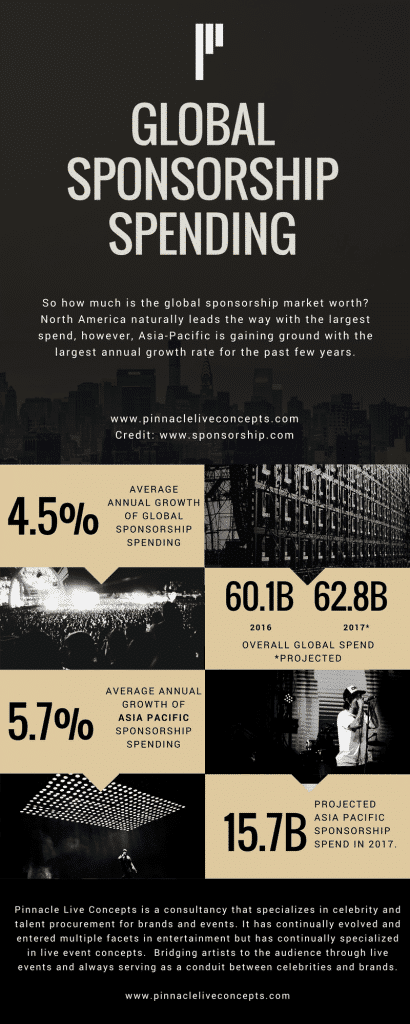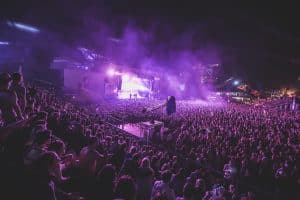Branding, Concerts, Festivals, Live Events, Sponsors
Celebrity Economics 101: A Crash Course in Valuation
Ever wonder how certain acts can command astronomical talent fees, yet someone more talented gets paid pennies on the dollar? Or how one DJ can get paid $100k, while a band of 5 gets paid a fraction the amount? Previously, there was a list of artist fees released online. Regardless if they were accurate or not at the time, they definitely aren’t now. Rather than discuss exact fees by basing it on a ‘rack rate’, let’s talk how we get to that fee and how to accurately price it out for a corporate endorsement or an event. I get inquiries about celebrity talent pricing quite often (daily, actually) and it’s such a broad question to answer. The best way to go about it is to understand that there are no flat rates or rack rates in the industry. If you’re quoted a price by a talent buyer or agent, without he/she knowing the workscope, it means it’s priced at a base commission they want. There are exceptions to this of course, but generally, high-profile celebrities go by a ‘market price’. Talent costs fluctuate like stocks or real estate; one day they’re hot, the next they’re not. Unless of course you’re Taylor Swift or Katy Perry – and yes, as blasphemous as it is, I put them in the same sentence. Let me go through my own personal valuation thought process. When it comes to celebrity talent buying, for concerts, endorsements, appearances, campaigns and festivals, there are variables to consider. The following is not a concrete formula but hopefully it helps in giving you a better perspective. Note that from this point on, I’ll be using the terms ‘celebrity talent’, ‘musician’ and ‘artist’ interchangeably. Who is the celebrity talent and how culturally relevant is he/she at the moment? Have they been nominated for or won awards recently? Supply/Demand – If the celebrity talent is extremely relevant and on international magazine covers regularly, the availability of the celebrity becomes slim. This may mean the musician/artist is on tour or off promoting a movie. Also, winning awards tend to spike the demand even more for the celebrity talent, since there is more press and publicity on them. This puts their price at a premium. Higher the demand, higher the price. Where will the celebrity talent be when you need their services? Will he/she be filming for a movie or television series, on tour, on vacation? Will the artist’s staff be on a hiatus or on another tour for a different act (dancers, backup singers, band members)? For location, it helps to know where the celebrity will be around the time you’ll be needing them. It’s a good way to determine travel costs, logistics, etc. It also helps to know if the artist is on a world tour, on vacation or on a honeymoon (yes, I’ve booked someone during their honeymoon before). All this is tough to find out, but if you have the information, it could help significantly. For instance, there has been a time when a musician had to decline an offer I submitted because he had been on hiatus for some time, and there wasn’t enough time for rehearsals for his band and dancers. Keep in mind that this is an important factor to consider. If the artist is on tour, is it with a global touring company or a self-promoted tour with local promoters? If the artist is touring with a group like Live Nation or AEG, this defines who you’ll need to contact (if the artist is even available at this point). If the artist however is touring on their own, or isn’t at all, there may be a possibility of touring the artist yourself or promoting a local show for them. If the artist is not on tour, or near your area, are you planning a one-off show/appearance or a regional tour offer? Is the artist entertaining offers at all? Willing to do a one-off? If it’s for a concert, what is the artist’s average ticket price previously? This is an important part of valuation. One-offs are generally on the pricier side simply because the artist will need to put together a touring team, staff and fly to the location of the show or appearance for one event. Especially if that flight is across the Pacific Ocean. Just looking at the time factor, flights from LA to Asia is almost 12hrs and factoring in the return flight, this is a whole day already on travel alone. Workscope wise, you’re already asking the artist for one additional day of work right off the bat. And if this artist is in high demand, that extra day will need to be taken into consideration. Regardless if it is a private show with a one-song performance, or a full-on public event, the costs begin to escalate drastically when you put the preparation time, workscope and amount of hours the artist has to spend on a flight into consideration. The cost difference between a one-off private show and a one-off public event is at most times, minimal. Economies of scale in tow, a one-off show is generally 50% pricier (if not double the market value of an act) for top-tier acts. This is when putting a run of shows together or hopping on a tour might be wiser and more economical. Most importantly, what is your bottom line? How much are you projecting to make on the deal and how much are you willing to pay for the celebrity talent in the process? One of the most important factors of determining value is the projected profit/loss statement. More in particularly used for ticketed concerts, this method can also be used to rationalize the ROI and payment for endorsers as well. This is best done by the local promoter who’s familiar with expenses in the city, whereas the Talent Buyer can assist in guiding with the basics. It’s standard to use the current ticket prices or rough market value to determine your base revenue. The more thorough and prepared you are with this, the chances of starting at an equitable price with a more efficient process is likely to happen. With this in consideration, you need to make sure that it is reasonable for both parties. It would be unfair for the artist to only get paid 5% of gross earnings and likewise, it would be unfair for you to get paid 5% too. This also helps with your minimum and maximum budgets for the celebrity. If the celebrity comes out to being out of budget, you’ll know when to move on or know when you need to bite the bullet and spend on talent. To help visualize what this looks like, here’s a sample P&L Statement. Special Consideration – Is the artist able to make it into your country? This doesn’t really concern the act all too much before you start talking, but if your country needs immigration permits, invitation letters, song lyrics approved and a criminal record check conducted, be sure to note that prior to approaching a celebrity. Places like China have restrictions (political and lyrical) and a lengthy permit process that involves the talent in question. Surprisingly, a country like Canada have specific immigration requirements as well. If you find out through your preliminary research that the celebrity would be denied entry, it might be best to seek alternatives prior to initiating talks. A nice and easy analogy I use when explaining about the process of celebrity talent buying is Real Estate. Let’s consider the celebrity talent as a house, and all the other celebrities out there the housing market. The celebrity’s rep (agent, manager, touring group, publicist) would be similar to the selling agent. You, the client/promoter, would be the equivalent to the house buyer, and if you chose to use a talent buyer, that talent buyer would be considered the buying agent for your future home. And in both instances, the buying agent is technically ‘optional’ but always provides four major benefits: market information (about the industry for the region), access (to deals not accessible to the public), reputation (in the industry to leverage better deals) and peace of mind (that you’re talking to the right people and the deal you’re signing is fair). The buying agent would take the client brief and look around the market for deals that match the client’s needs. And in specific cases, the client may point the buyer directly to what he/she wants to buy. Here, when a house or talent is short-listed, the buying agents and selling agents negotiate a deal fair to both parties based on its market value – and this is where the information about the market is beneficial. Ultimately, knowing about which celebrity gets paid the most for a performance isn’t so much about reading rumors from paparazzi or tabloids or even Googling it. It is more about the economics and the true market value. And for the businesses out there, information and research is the key in finding a fair market value for anyone you are hoping to bring in for your concert or product.
0






